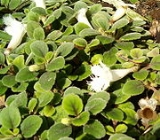
Alsobia
Encyclopedia
Alsobia is a genus
of flowering plant
s in the family Gesneriaceae
, native to Mexico, Guatemala and Costa Rica.
The two species are succulent, stolon
iferous herb
s and were previously included in the genus Episcia
. Recent molecular studies have supported the separation of Alsobia from Episcia.
Genus
In biology, a genus is a low-level taxonomic rank used in the biological classification of living and fossil organisms, which is an example of definition by genus and differentia...
of flowering plant
Flowering plant
The flowering plants , also known as Angiospermae or Magnoliophyta, are the most diverse group of land plants. Angiosperms are seed-producing plants like the gymnosperms and can be distinguished from the gymnosperms by a series of synapomorphies...
s in the family Gesneriaceae
Gesneriaceae
Gesneriaceae is a family of flowering plants consisting of ca. 150 genera and ca. 3,200 species in the Old World and New World tropics and subtropics, with a very small number extending to temperate areas. Many species have colorful and showy flowers and are cultivated as ornamental plants.Most...
, native to Mexico, Guatemala and Costa Rica.
The two species are succulent, stolon
Stolon
In biology, stolons are horizontal connections between organisms. They may be part of the organism, or of its skeleton; typically, animal stolons are external skeletons.-In botany:...
iferous herb
Herb
Except in botanical usage, an herb is "any plant with leaves, seeds, or flowers used for flavoring, food, medicine, or perfume" or "a part of such a plant as used in cooking"...
s and were previously included in the genus Episcia
Episcia
Episcia is a genus of about 8 species belonging to the flowering plant family Gesneriaceae. The species are found in the tropical regions of Central America and South America...
. Recent molecular studies have supported the separation of Alsobia from Episcia.
Species
- Alsobia dianthiflora (syn. Episcia dianthiflora)
- Alsobia punctata (syn. Episcia punctata)
Further reading
- Wiehler, H. 1978. The genera Episcia, Alsobia, Nautilocalyx, and Paradrymonia (Gesneriaceae). Selbyana 5: 11-60.

